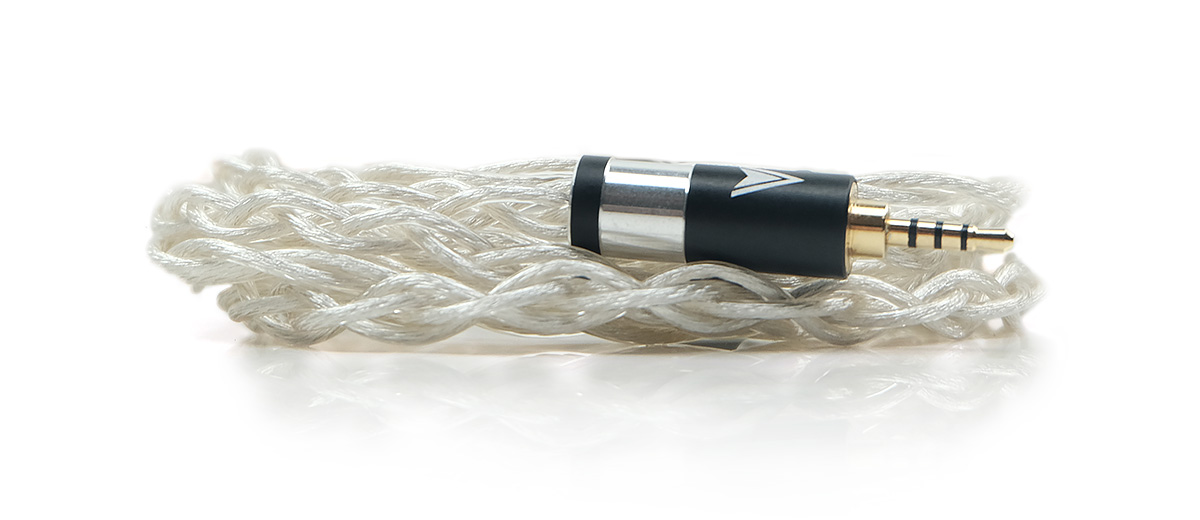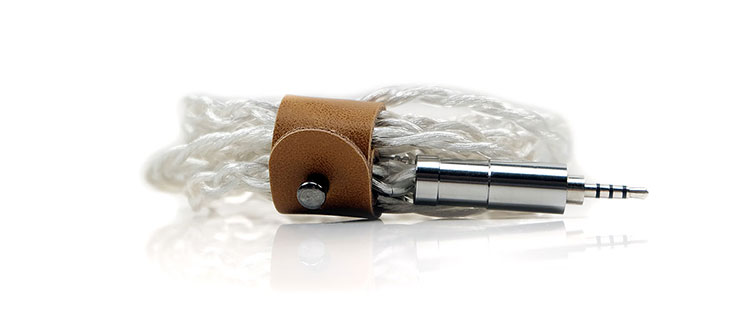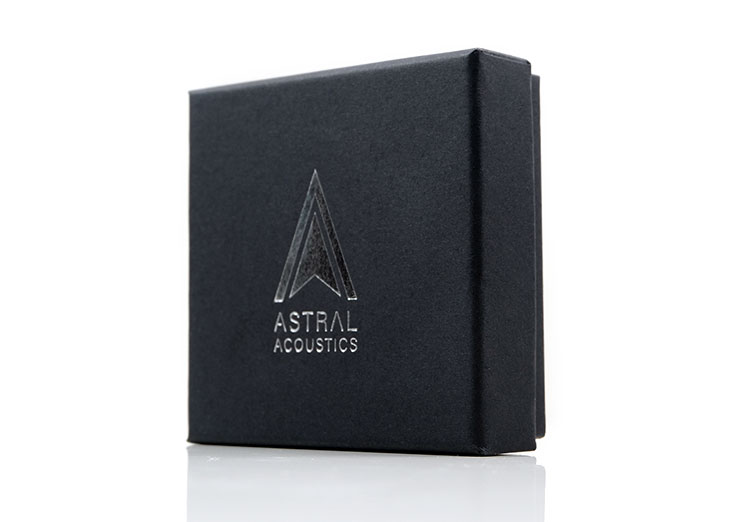Select Comparisons
For all comparisons, we used a mix of the HiBy RS8 and the Cayin N8ii sources combined with the VE Phonix, Noble Audio Viking Ragnar, and the FiR Audio Krypton 5 IEMs.
Astral Acoustics Reference Silver
The Reference Silver is the company’s penultimate aftermarket pure silver cable and the next down from the flagship Eclipse. You can read our full review of Reference Silver here.
$750
Technical
On the surface, these two cables would seem to be very similar. Both use a 5N Silver composition in a 4-core geometry. In fact, with a larger 23.5AWG rating compared to 24AWG, you could be forgiven for thinking the Reference Silver has the chops to take on the Eclipse.
However, there are subtleties in the build that give the Eclipse a lift, including a higher purity 5N silver that is not an OCC variant, and though there are fewer strands, the Eclipse stranding is thicker by design. The soldering is also a grade up which is an important aspect of cable building.
Both cables are Litz, though the Eclipse is a Type 4 compared to a Type 6 Litz, and here again, some might wonder why a slightly simpler Litz geometry.
This one comes down to a tuning preference, with the Type 4’s looser construction allowing Astral Acoustics to tease out the more ‘musical’ performance from the Eclipse compared to the tighter, cleaner tone of the Reference Silver.
Design
Strikingly similar aesthetics on the general wire side, with a silvery hue behind a transparent and very soft PVC jacket combined with a very clean braiding technique.
However, a very different approach to the finishing with a more mature set of connectors on the Eclipse. I am still a fan of the TA4 titanium barrels on the Reference Silver and they feel wonderfully robust but they are quite heavy also.
The newer black and silver alu7075 barrels, (aluminum) on the Eclipse are much lighter, and indeed, the cable feels lighter overall as a result.
They also have a bit more intricacy in the engineering and finishing with the two-tone black and silver finish so the finishing does look more mature.
Handling between the two is much the same, save for the better weight distribution on the Eclipse, which makes it less liable to swing from the base when not plugged in.
It might also produce a little less stress on more delicate jacks, such as those on earlier AK and Pioneer DAPs. Therefore, I would rate microphonics as low for both cables.
Performance
A pretty easy change-up between these two cables when switching between both on the Viking Ragnar. The Eclipse is both warmer, smoother, and slightly softer on the upper mids and treble of the Noble tuning using the HiBy RS8.
Now, I use Final E tips on the Ragnar simply because of how it accentuates the low-end response over the stock foam variants but in doing so I have to allow for a bit more steeliness on the highs which to date I have soothed somewhat by using the R2R RS8 as a source.
The Reference Silver does not upset that balance but you will still pick up that slight odd-harmonic bias in the vocals and upper mids, (and beyond).
Some of that bias comes from a reduced low-end weight from the Silver in comparison to the Eclipse. You simply get more of both from the Astral Acoustics flagship which stretches the staging dimensions offering improved depth as well a very important emphasis on weightier fundamentals.
That’s perhaps the most significant impression when you start listening to these two cables, the full-blooded sound from the Eclipse compared to the tight, clean, and precise Reference Silver performance.
If you are a mids lover and like it neutral and clean that is not a bad thing at all. The Reference Silver still impresses me with its eye for detail and excellent treble sparkle that teases out some good upper mids energy.
However, if you want improved depth, weight, and power along with a more natural tone and richness in the Viking timbre then the Eclipse is the superior or more versatile pick.
PLUSSOUND Silver+
$1499.99
The PLUSSOUND Silver+ is technically the flagship of the company’s new coaxial wire range, the others being the award-winning Hybrid+ and the Copper+. You can read our full review of the Silver+ here.
Technical
A very different approach to cable building here between the Eclipse and the Silver+. You could argue that the Eclipse is a more traditional geometry with its 4-core 5N high-purity silver 24AWG wire and Type 4 Litz.
The Silver+, on the other hand, is a coaxial cable. That means it is a similar 4-core 24AWG rating but with an inner conductor and an outer shield sharing a geometric axis with a core 24AWG UP-OCC in a single twist configuration and an outer layer of UP-OCC silver in a 5-strand Litz configured bundles.
In between there is a new second clear type layer of PS insulation to isolate that core single silver twist from the 5 strands twisted bundle outer layer. You then have a main PS insulation jacket wrapped around that outer UP-OCC silver 5-strand twisted bundle.
Still with me? It’s complex let’s put it that way and it does have an effect on the overall handling also being a lot stiffer than the Eclipse.
Design
That stark contrast in vision is also present in the two cables’ aesthetics. The Eclipse is what I call the classic approach, and its main advantage is the softness and playability of its handling.
The thicker innards of the Silver+ mean a longer braid throw and a stiffer PVC-protected build. You can also get the Silver+ in a twisted format, which slims the profile but makes it much harder to handle in comparison.
No such issues with the Eclipse design, which is as soft and pliable as they come. The braiding is equally tight but the softer PVC jacket reduces microphonics noticeably better for me when both are in use.
I do give an edge on the finishing to PLUSSOUND, but I would say that for most matchups. Not so much in the flare of the designs but in the quality of the components and how long they last.
PLUSSOUND’s screw-tight barrels and hot-stamped metallic heat shrinks are superb and built to last. They look ultra-tidy and will not dry out and loosen up over time.
It’s too early to say if the new aluminum barrels on the Eclipse will hold true, but they are developing with a more unique and complex look that complements the wire in terms of aesthetics.
Alternative color and shape options are not as plentiful with the Eclipse finish, though. With the Silver+, you can have a wide variety of cinch and barrel materials to allow you to make the most aesthetically pleasing choice.
Performance
What you take away from these two cables is mainly going to come down to a preference thing because they both have key areas that outperform each other.
In this instance, I went with the FiR Audio Krypton 5 with the Cayin N8ii which is going to deliver a fairly smooth but bass-heavy response, especially using the N8ii P+ mode. The Eclipse did not let me down in that regard allowing for the full weight and sub-bass rumble of the Krypton 5 to shine through.
The Silver+ was more reserved so a bit of depth is shaved off comparatively speaking but does yield a bit more clarity and treble presence which, in turn, helps with note definition a bit more and shortens the relative perceived note decay also.
That translated to a peppier cleaner mid-bass punch, perhaps more agility also as well as a more vivid midrange, one that came forward quite nicely.
The Eclipse performance with this combo is full sounding, and more natural but also a bit more relaxed through the mids and highs. You get a smooth delivery but not quite as vivid or as clean in the vocal performance. It does yield better textural depth on the lows up to the lower mids and for pop, rock, and R’n’B I would pick it over the Silver+.
The Silver+ is a mids lover’s cable for those who want clarity and precision. It is not a bright cable though, rather it just doesn’t tease out that weight and power quite as much as the Eclipse.
Does that mean the Krypton 5 is a solid Eclipse pairing? On a high level yes, but I did enjoy the cleaner midrange from the Silver+ performance when things went a bit quiet and intimate in the audio tracks.
Satin Audio Athena
$799
The Satin Athena was launched back in 2019 and, whilst not a flagship, it did and still does represent excellent value in today’s cable market. You can read the full review of the Athena here. Do note, however, that there is an Athena II out recently that we will be reviewing shortly.
Technical
The Athena differs in its type of silver, with a hybrid palladium silver mix rather than the Eclipse’s singular high-purity 5N silver composition.
Palladium is quite an expansive material, even on a purely plating level. Though less conductive than silver, it can and is used by cable manufacturers to produce levels of frequency attenuation in areas where single metal elements cannot be used to the same effect.
This can alter the performance with degrees of warmth or smoothness depending on the designer’s preference.
The geometry is perhaps the previous gen in cable making for the Athena, at least for me. It’s a classic 26 AWG hybrid of SP-OCC palladium-plated silver mixed with SP-OCC pure silver in a multi-size strand type 4 Litz geometry, but to get that additional dynamic range, it’s an 8-wire as opposed to a 4-wire.
Now, for the last year or two, companies have been playing around with bigger gauges to remain at a 4-wire level but achieve the same level of dynamic range or lower resistance.
That also allows the cable to remain light and flexible. Hence the Eclipse is 4-wire but with a thicker strand as well as a bigger gauge at 24 AWG. It also retains the same Type 4 Liz build as the Athena.
Design
That 8-wire build does make a difference, both in the dimensions and size of the Athena compared to the Eclipse. This is a fatter and heavier cable with a slightly off-white appearance due to the hybrid silver and palladium mix.
It is also a looser braid due to Satin Audio’s very soft SA Insulation II jacket, which is a bit softer than the Eclipse PVC version.
However, I prefer the tighter braiding technique for the Eclipse. Over time, I have found the long throw of the Athena braiding to develop messy loops. You can massage them back into shape but it’s something to be aware of when using it.
The finishing on both is good, but you can tell from the Athena that it is a last generation, with a very familiar two-tone carbon fiber barrel finish, as opposed to the slimline aluminum two-tone barrels on the Eclipse.
It’s finished very well, but as with the Athena II out recently, companies are becoming more niche and complex in their barrel designs. There is also a slight weight advantage with the Eclipse barrels, though to be fair, the Athena strain relief finishing is just as good.
Microphonics on both are very low, but the lighter form factor of the Eclipse might suit more for on-ear pressure and general handling when in use. Both have different termination options, but Satin Audio has an advantage in terms of plug selection, which is vast.
Performance
Testing with the Phonix and the Viking Ragnar I felt the tone of the Athena pairing was a lot closer to the direction the Eclipse is taking than either of the other two silver creations we have compared thus far.
Both err more to the musical and full-sound though having gone back and forth I would say the snap and power of the Eclipse performance with both monitors has an edge for me.
On the flip side, the treble extension from both IEMs also felt more complete with the Eclipse. There is some perceived headroom improvement and air for vocals to breathe and take center stage.
Now, the Athena does image quite well for vocals it does seem more forward sounding than the Eclipse, especially on the Viking Ragnar.
However, I don’t get the same feeling of space below and around them so they seem comparatively flatter to me in their presentation with instruments standing a bit more side to side than around and behind.
That was a lasting impression for me, just a shade less depth and height reducing the holographic dimension compared to the Eclipse. The dynamic range is there, fairly comparable and you will not notice much difference, which is a good thing.
The timbre of the Athena is a shade drier than the Eclipse with both monitors. That might not gel quite as well with the Ragnar but works well with the warmer tuning of the Phonix.
I would honestly pair the Eclipse much quicker with the Ragnar. Percussion timbre is more natural and weightier sounding and combined with a more refined imaging experience it sounds the more mature and immersive pairing.
Our Verdict
The Astral Acoustics Eclipse is perhaps one of the smoothest-sounding silver cables I have heard to date. Also, heaven knows what Henry and his team have slipped into the ‘proverbial coffee’ to also provide that amount of ‘welly’ on the low end to most of my dynamic driver and larger subwoofer IEMs.
It’s an impressive bass performer, an attribute I normally associate with a good-quality SPC wire. And yet here we are with a beautifully crafted and easy-to-handle cable with silver at its core that probably ‘out-coppers’ most copper cables.
I think I will keep this in the bag with the Noble Viking Ragnar. I have been on the lookout for an alternative to the already excellent stock cable just in case something happens to it. This one is a very good match indeed. I was not expecting that.
Astral Acoustics Eclipse Specifications
- Core: 4 wire
- Gauge: 24 AWG
- Geometry: Type 4 Litz
- Material: 5n Silver
- Length: 120cm








